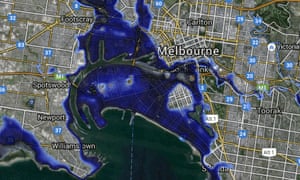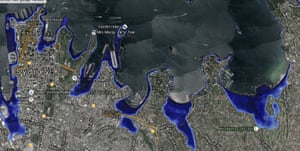ABC - Mike Steketee*
The aversion to talking about climate change during the election campaign reflects a wider problem: our concern for this issue has fallen even while it has become larger and more urgent.
 |
| The so-called pause in global warming was no more than a temporary slowdown in the rate of temperature increase. (Reuters/Kathryn Hansen/NASA) |
How much of an issue will climate change be in this year's election?
Not
a major one, if Malcolm Turnbull gets his way. He has saddled himself
with Tony Abbott's policy as one of the costs of appeasing the
conservatives in his ranks.
And while Bill Shorten will be arguing
he has a superior policy - but also risking a fear campaign over
re-introducing a carbon tax - Labor, too, believes it has bigger fish to
fry, such as pushing forward its credentials on education and health.
This
reflects a sobering reality: in the last eight years, many Australians'
concern over climate change has fallen even while the problem has
become larger and more urgent.
The market research company Ipsos has been conducting surveys on the issue since 2007. In that year
54 per cent of people
who were presented with a list of issues said climate change was one
that needed to be addressed. In the latest report, still to be released,
this fell to 38 per cent last year. This is about the same as for the
previous two years, although higher than in 2011 and 2012.
Different
descriptions on the list for essentially the same issue confirmed the
finding, but more strongly. For example, concern about tackling "global
warming" fell from 55 per cent to 35 per cent over the eight years.
Renewable energy was at the top of the list of issues that needed to be
addressed but it also has fallen significantly - from 68 per cent to 51
per cent.
Perhaps people are less concerned because some action
has been taken. But if this is true of renewable energy, where the
government has set a (reduced) target of 22.5 per cent by 2020 and Labor
50 per cent by 2030, it is hard to argue the same on other issues.
Concern
about the need to address rising sea levels has fallen from 29 per cent
to 17 per cent over the eight years. Sea levels rose by an estimated
global average of 17cm between 1900 and 2005 and according to recent
research,
nearly 70 per cent of the increase since 1970 was due to human influences - that is, the thermal expansion of the oceans and the melting of glaciers due to burning fossil fuels.
The argument has been that scaring people with stories about bushfires, cyclones and melting glaciers does not work.
We may just be getting started. Though the timing
remains uncertain, scientists know that global warming can produce a
tipping point at which there are large and irreversible losses of ice,
causing sea level rises of metres, not centimetres.
Public concern
about climate change in 2007 coincided with the millennium drought and
water shortages. It also meant that the Howard government went to the
election that year promising an emissions trading scheme, similar to the
one that Kevin Rudd undertook to implement as prime minister before
getting cold feet and for which Turnbull's support cost him his job as
opposition leader.
Howard subsequently sided with Tony Abbott and other conservatives in his party and conceded that it was public pressure that forced his hand in 2007.
That
makes the point about our current situation: the message on climate
change is not coming through strongly enough to put pressure on the
government to adopt a tougher policy.
Often the strategy by
interest groups and politicians has been to accentuate the positives,
such as a clean energy future and green jobs. The argument has been that
scaring people with stories about bushfires, cyclones and melting
glaciers does not work.
But it also has meant ceding ground to
climate sceptics. They certainly did not worry about selling their
message too hard: to the contrary, they thrived on their shrill advocacy
to grab attention.
Their success in challenging the overwhelming
scientific consensus on the human causes of global warming, as
documented by Naomi Oreskes and Erik M. Conway in their 2010 book
Merchants of Doubt, was to create uncertainty in the public mind and
give the impression of a debate between two more or less equal sides.
The signs now are that attitudes are changing. An
Essential poll last month
found that 63 per cent of people agreed with the statement that there
was fairly conclusive evidence that climate change was happening and was
caused by human activity. This was up from 56 per cent in November last
year. Those who agreed that we might just be witnessing a normal
fluctuation in the earth's climate fell from 32 per cent to 27 per cent.
The signs of a more receptive public provide an opportunity to
elevate climate change from a second order issue during the election
campaign.
The yet-to-be-published data from Ipsos shows a jump
from 27 per cent to 44 last year in the group of so called "active
believers" - those with a strong sense of urgency and concern about
climate change. Ipsos research director Jennifer Brook says that
although the size of the increase surprised her, there are signs of "a
general shift to acceptance that climate change is something that is a
threat and needs to be tackled".
It is possible that this also
could be mainly caused by another El Nino year. But in the longer run it
is becoming harder to ignore the accumulating evidence.
February
of this year was the 10th consecutive month of record-breaking global
temperatures and, at 1.21C above the average for the last century, it
was the largest amount above the average for any month on record. Last
year was the hottest year recorded globally and
14 of the 15 hottest years have occurred in the last 15 years.
Unusually high sea surface temperatures in the tropics during last summer have contributed to the
longest coral bleaching ever seen on the Great Barrier Reef.
Arctic sea ice shrunk to its lowest ever area in January and February.
And
so on. It is now clear the so-called pause in global warming seized on
by climate sceptics was no more than a temporary slowdown in the rate of
temperature increase.
Nevertheless there remains considerable
ignorance about climate change. When people were presented in the Ipsos
survey with a list of possible causes, the largest number - 55 per cent -
chose greenhouse gas emissions from industry and burning of fossil
fuels. But 32 per cent picked the hole in the ozone layer and 22 per
cent rubbish or litter - neither of which are responsible for warming.
(Respondents could pick more than one cause).
This drives home the need to push a stronger message. In the words of last year's Ipsos report:
Despite
Australians' acknowledgement of the impacts of climate change, there is
clearly a need for consistent, clear and simple information about
climate change, especially the causes.
The signs of a
more receptive public provide an opportunity to elevate climate change
from a second order issue during the election campaign.
There have
been major progress in recent years to curbing carbon emissions,
particularly in China and notably driven at least in part by public
concern over smog produced by industry.
Global energy-related carbon dioxide emissions have stayed flat for the last two years,
according to the International Energy Agency. It adds that renewables
accounted for about 90 per cent of new electricity generation last year.
But in Australia emissions from electricity generation have continued growing - by 3 per cent in 2014-15 -
and emissions overall have increased by 1.3 per cent.
The
Ipsos research shows stronger public support for the Coalition's direct
action policy than for the emissions trading scheme advocated by Labor
perhaps mainly because the former is easier to understand, even though
most experts argue that the latter is more effective.
The Grattan Institute this week proposed a pragmatic solution
- building on direct action by gradually reducing emission limits and
introducing elements of emissions trading. That offers one way,
particularly for Turnbull, to harness public opinion to move forward
against recalcitrant in his party.
*Mike Steketee is a freelance journalist. He was formerly a columnist and national affairs editor for The Australian.





